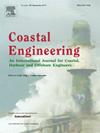Full-scale experimental study on wave impacts at stepped revetments
IF 4.2
2区 工程技术
Q1 ENGINEERING, CIVIL
引用次数: 0
Abstract
Stepped revetments are known to be more effective in limiting wave overtopping and wave run-up than sloped revetments. However, literature on wave-induced impact pressures and comprehensive guidelines on the practical design for these structures is scarce. Laboratory experiments support the development of design recommendations. To date, studies for wave impacts at stepped revetments have mainly been carried out at small scales. This study characterizes wave-induced impact pressures at full scale, derives practical design formulae and evaluates findings against established methods for vertical walls and sloping structures. Additionally, an insight into the influence of scale is given by comparing wave impact characteristics for design cases between tests at multiple scales. Flume experiments with a slope of 1:3 and uniform step heights of 0.17 m and 0.50 m were investigated in the Large Wave Flume (GWK) in Hannover, Germany. Horizontal and vertical wave-induced pressure impacts were measured at 15 distinct locations for a large range of wave-breaking types (1.8 < ξm-1,0 < 2.8). Wave impact characteristics on stepped revetments align more closely with those observed on vertical walls than on sloped structures. Horizontal impacts are dominant over vertical impacts across the entire tested parameter range and thus critical for design considerations. Results show that previous small-scale tests significantly overestimate the maximum wave-induced impact pressures by a factor of 5.0 and maximum forces by a factor of 2.4. Impact loads occur significantly faster than at small scale. Design quasi-static pressures above the still-water level can be calculated and maximum horizontal impact pressures can be scaled using existing methods for vertical walls. Practical design formulae are derived for horizontal and vertical design pressures for different types of wave-breaking, for the vertical distribution of horizontal wave-induced impact pressures as well as for the temporal characteristics of these pressures at stepped revetments.
波浪对阶梯式护岸冲击的全尺寸实验研究
阶梯式护岸比坡式护岸更有效地限制了波浪的过顶和上升。然而,关于波浪冲击压力的文献和对这些结构的实际设计的综合指南很少。实验室实验支持设计建议的发展。迄今为止,波浪对阶梯式护岸的影响研究主要是在小尺度上进行的。本研究在全尺寸下表征了波浪引起的冲击压力,推导出实用的设计公式,并对垂直墙和倾斜结构的既定方法进行了评估。此外,通过比较多尺度试验中设计案例的波浪冲击特性,深入了解了尺度的影响。在德国汉诺威的大波浪水槽(GWK)中进行了坡度为1:3,台阶高度均匀为0.17 m和0.50 m的水槽试验。在15个不同的位置测量了水平和垂直波浪引起的压力冲击,范围很大的破波类型(1.8 <;ξm - 1, 0 & lt;2.8)。与斜坡结构相比,阶梯式护岸的波浪冲击特性与垂直墙壁上观察到的波浪冲击特性更接近。在整个测试参数范围内,水平冲击比垂直冲击占主导地位,因此对设计考虑至关重要。结果表明,以往的小规模试验显著高估了最大波浪冲击压力5.0倍,最大作用力2.4倍。冲击载荷的发生速度明显快于小规模试验。可以计算静止水位以上的设计准静态压力,并且可以使用现有的垂直墙方法缩放最大水平冲击压力。推导了不同破波类型的水平和垂直设计压力、水平波浪冲击压力的垂直分布以及这些压力在阶梯式护岸上的时间特征的实用设计公式。
本文章由计算机程序翻译,如有差异,请以英文原文为准。
求助全文
约1分钟内获得全文
求助全文
来源期刊

Coastal Engineering
工程技术-工程:大洋
CiteScore
9.20
自引率
13.60%
发文量
0
审稿时长
3.5 months
期刊介绍:
Coastal Engineering is an international medium for coastal engineers and scientists. Combining practical applications with modern technological and scientific approaches, such as mathematical and numerical modelling, laboratory and field observations and experiments, it publishes fundamental studies as well as case studies on the following aspects of coastal, harbour and offshore engineering: waves, currents and sediment transport; coastal, estuarine and offshore morphology; technical and functional design of coastal and harbour structures; morphological and environmental impact of coastal, harbour and offshore structures.
 求助内容:
求助内容: 应助结果提醒方式:
应助结果提醒方式:


